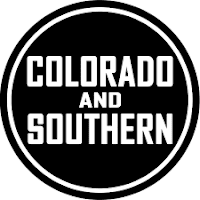The basic idea of any 18xx game is to run a company and make the decisions about what trains to buy, what track to build and if the company will pay dividends or not. There are a lot of nuances there but that's really what it boils down to. Obviously you won't have much of a game without some companies to run then. Most 18xx games start this off with the sale of private companies, the number varies per game but typically those must be sold off first before anyone can purchase a minor company (kind of works like a major company but without stock shares) or a stock company (the universal standard seems to be 10 shares each representing 10% with a president certificate worth 2 shares).
If we start looking at the history of Colorado railroads we see the first such company being established in 1861; The Colorado & Pacific Wagon, Telegraph and Railroad Company which would run until 1871 and become the Clear Creek & Dry Gulch Wagon Road Company. This company would exist until 1873 when it would become the Colorado Central Railroad which in turn had been created from the Colorado Central & Pacific railroad established in 1866 becoming the Colorado Central Railroad in 1869. The Colorado Central Railroad would become part of the Union Pacific, Denver & Gulf Railway in 1890 which then would become part of the Colorado & Southern Railroad in 1898. The Colorado & Southern was created by not only absorbing the UPD&G but a number of other railroad companies as well. The Colorado & Southern would exist until 1981 when it was finally completed absorbed by the Burlington Northern RR. So not only is that a complicated existence but every company involved was controlled by the Chicago, Burlington & Quincy which itself merged with the Great Northern and the Northern Pacific to create the Burlington Northern in 1970. The CB&Q itself only operated on the plains of Colorado all of its mountain interests were handled by both small and medium sized railroads that it controlled. And that's just one example of the craziness you will find in the ownership and control of Colorado railroads.
There were 165 railroads formed or operating in Colorado from 1861 to 2000. If you take away a the terminal railroads you are down to 163 (you might be able to push a couple more into that category with a little more thought). Let's arbitrarily choose and end date of 1928 as the outside limit for companies that could be included in the game and we are done to 152 (more or less). That's not helping much let's look at it a different way. From 1861-1869 seven railroads were formed (perhaps the survivors from this period become the initial batch of private companies). From 1870-1879 seventeen railroads were formed. From 1880-1889 fifty-five railroads were formed, from 1890-1899 twenty-nine railroads were formed. From 1900-1909 twenty-seven railroads were formed. From 1910-1919 eleven railroads were formed and from 1920-1929 seven railroads were formed. Obviously a good chunk of railroads created absorbed older railroads or were just re-named because of re-organizations which resulted in a "new" railroad. For instance there was a small railroad than ran from Boulder Colorado to Ward Colorado; formed in 1897 as the Colorado & Northwestern Railway. It was re-organized in 1904 as the Colorado & Northwestern Railroad and again in 1909 as the Denver, Boulder & Western Railroad which shuttered the doors after 1919 after a flood wiped out a good chunk of its track in lower Boulder Canyon in 1918. As you can see then while 165 railroads were formed there were far from that many actually operating.
It seems like the best place to start would be to select 1880 as the starting point for the game. Private companies would be those that were active prior to 1880 but still operating as of 1880. After that it starts to become a bit of a guessing game on which companies might be better represented as minor companies with potential to be merged into a single system (which is how the Colorado & Southern was created) and which could actually be full fledged stock companies like the Denver & Rio Grande which was initially formed in 1870. There is obviously a lot of research that needs to be done here as well. Plus how do you handle all the small companies created and controlled by the CB&Q? Perhaps, unlike other 18xx games, there is a continual influx of private companies being created as the game progresses.
A lot of these railroads were built almost exclusively to pull ore out of the mountains and down to the smelters. Ores like gold, silver and, especially during WWI, tungsten. Boulder county was the largest producer of tungsten in the US and it was greatly needed for the munitions industry during WWI. Should there be a complication for WWI? During this period the railroads were run by the United States Railroad Administration (USRA) to make sure rail traffic moved war materials and men efficiently.
I think we can safely ignore the USRA period; December 1917 through March of 1920 as an unnecessary complication, but I think the addition of revenue from mines (the transportation of the ore from the mines to the smelters) needs to be considered. If its included then railroads like the Colorado & Northwestern could, potentially, be included somehow. Definitely something to look at and its something I think at least a couple of other 18xx games include. It would certainly help finance the laying of track that is going to be required.





No comments:
Post a Comment